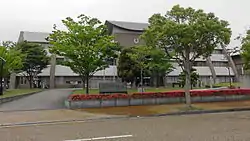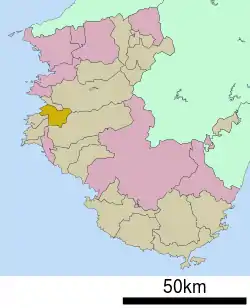Hirogawa, Wakayama
Hirogawa (広川町, Hirogawa-chō) is a town in Arida District, Wakayama Prefecture, Japan.
Hirogawa
広川町 | |
|---|---|
Town | |
 Hirogawa Town hall | |
 Flag | |
 Location of Hirogawa in Wakayama Prefecture | |
 Hirogawa Location in Japan | |
| Coordinates: 34°2′N 135°10′E | |
| Country | Japan |
| Region | Kansai |
| Prefecture | Wakayama Prefecture |
| District | Arida |
| Area | |
| • Total | 65.35 km2 (25.23 sq mi) |
| Population (October 1, 2016) | |
| • Total | 7,059 |
| • Density | 110/km2 (280/sq mi) |
| Time zone | UTC+09:00 (JST) |
| Website | www |
As of 2016, the town had an estimated population of 7,059 and a density of 110 persons per km². The total area is 65.35 km².
History
Thanks to the story Inamura no Hi: The Burning Rice Fields by Tsunezo Nakai (translated and published in English by Sara Cone Bryant) and Lafcadio Hearn's Gleanings in Buddha-Fields (1897), Hirogawa (then Hiro-Mura) is often referred to the home of "A Living God": Goryo Hamaguchi (1820-1885).
In 1854, Goryo Hamaguchi saved many lives from the tsunami struck the Kii Peninsula following the big earthquake. He set fires to rice sheaves (inamura) to help guide those in great danger to safety on the hilltop. He also devoted himself to help fellow villagers find jobs (hiring them) and build confidence by constructing a huge seawall.
Goryo Hamaguchi and others established a private academy called "Taikyu-sha" (current Taikyu Junior/High School) to give the villagers the opportunity to learn. (According to the school record, they are not teaching the way to be successful or be famous but to be practical in many ways, such as farming and ironing.)
In 1907, George Trumbull Ladd, assisting Marquis Ito (Hirofumi), visited the school and later published his journal Rare Days in Japan (1910) in the U.S.
In literature
George Trumbull Ladd briefly described his visit in another book In Korea with Marquis Ito (1908) as follows:
We had taken a trip to the village of Hiro Mura, where formerly lived Hamaguchi Goryo, the benevolent patron of his village, whose act of self-sacrifice in burning his rice straw in order to guide the bewildered villagers to a place of safety when they were being overwhelmed by a tidal wave in the darkness of midnight, has been made the theme of one of Lafcadio Hearn’s interesting tales. Mr. Hearn, it appears, had never visited the locality; and, indeed, we were assured that we were the first foreigners who had ever been in the village streets. A former pupil of mine is at the head of a flourishing school patronized by the Hamaguchi family; and having accepted his invitation, in the name of the entire region, to visit them and speak to the school and to the teachers of the Prefecture, the cordial greeting, hospitable entertainment, and the surpassingly beautiful scenery, afforded a rich reward for the three or four days of time required. For, as to the scenery, not the drive around the Bay of Naples or along the Bosphorus excels in natural beauty the jinrikisha ride that surmounts the cliffs, or clings to their sides, above the bay of Shimidzu (“Clear Water”); while for a certain picturesque-ness of human interest it surpasses them both. On the way back to Wakayama – for Hiro Mura is more than twenty miles from the nearest railway station- three men to each jinrikisha, running with scarcely a pause and at a rate that would have gained credit for any horse as a fairly good roadster, brought us to the well-situated tea-house at Wakano-ura. For centuries the most celebrated of Japanese poets with the women gathering seaweed at low tide, the fishermen in the offing, the stocks standing on one leg in the water or flying above the rushed of the salt marsh. Here we were met for tiffin by the Governor of the Prefecture and the mayor of the city, and immediately after escorted to the city hall of Wakayama where an audience of some eight hundred, officials and teachers, had already assembled. While in the waiting-room of this hall, a telegram from Mr. Yokoi was handed to me, announcing that Marquis Ito had already left Oiso and would reach Kyoto that very evening and arrange to see me the next day.
See also
Further reading
- Ladd, George T. (1908). In Korea with Marquis Ito
External links
 Media related to Hirogawa, Wakayama at Wikimedia Commons
Media related to Hirogawa, Wakayama at Wikimedia Commons- Hirogawa official website (in Japanese)